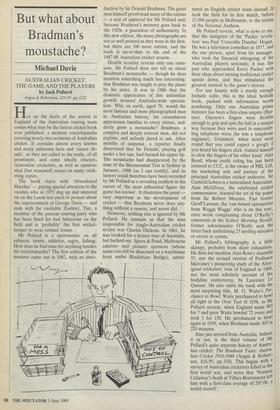But what about Bradman's moustache?
Michael Davie
AUSTRALIAN CRICKET: THE GAME AND THE PLAYERS by Jack Pollard Angus 4:4c Robertson, £29.95, pp.1231 Hot on the heels of the arrival in England of the Australian touring team comes what may be the fattest cricket book ever published: a monster encyclopaedia covering nearly two centuries of Australian cricket. It contains almost every known and many unknown facts and 'career de- tails', as they are called in the trade, of all prominent, and some wholly obscure, Australian cricketers, as well as opinion- ated (but reasoned) essays on many crick- eting topics.
The book starts with 'Abandoned Matches' — paying special attention to the vandals who in 1975 dug up and smeared oil on the Leeds test pitch to protest about the imprisonment of George Davis — and ends with the excitable Zoehrer, Tim, a member of the present touring party who has been fined for bad behaviour on the field and is 'probably' the first wicket- keeper to wear contact lenses.
Mr Pollard is a sportswriter on all subjects: tennis, athletics, rugby, fishing. How does he find time for anything besides his encyclopaedia? The first edition of the monster came out in 1982, with an intro- duction by Sir Donald Bradman. The great man himself proof-read many of the entries — a seal of approval for Mr Pollard and, because Bradman's memory goes back to the 1920s, a guarantee of authenticity. In this new edition, the many photographs are not so well printed as they were in the first, but there are 100 more entries, and the book is up-to-date to the end of the 1987-88 Australian cricket season.
Hostile scrutiny reveals only one omis- sion. Mr Pollard does not tell us about Bradman's moustache — though he does mention something much less interesting: that Bradman was taught to play the piano by his sister. It was in 1986 that the dramatic appearance of this unfamiliar growth aroused Australia-wide specula- tion. Why on earth, aged 78, would the most famous and most photographed man in Australian history, his cleanshaven appearance familiar to every citizen, sud- denly grow a moustache? Bradman, a complex and deeply reticent man, did not explain; and nobody dared to ask. After months of suspense, a reporter finally discovered that Sir Donald, playing golf under a hot sun, had burned his upper lip. The moustache had disappeared by the time of the Bicentennial Test in Sydney in January, 1988 (as I can testify), and its history could therefore have been recorded by Mr Pollard as a revealing incident in the career of 'the most influential figure the game has known'. It illustrates the point very important in the development of cricket — that Bradman never does any- thing without a reason, and never did.
However, nothing else is ignored by Mr Pollard. He reminds us that the man responsible for Anglo-Australian cricket rivalry was Charles Dickens. In 1861, he was booked for a lecture tour of Australia, but backed out. Spiers & Pond, Melbourne caterers and pioneer sponsors (whose name can still be discerned on a warehouse front under Blackfriars Bridge), substi- . tuted an English cricket team instead. It took the field for its first match, before 15,000 people in Melbourne, to the strains of the National Anthem.
Mr Pollard reveals, what is news to me, that the instigator of the 'Packer revolu- tion' was Paul 'Crocodile Dundee' Hogan. He was a television comedian in 1977, and the one person, apart from his manager, who took the financial whingeing of the Australian players seriously; it was this pair who approached Kerry Packer with their ideas about turning traditional cricket upside down, and thus stimulated the greatest turmoil in the game's history. For any fanatic with a sturdy enough bedside table, this is the ideal bedside book, packed with information worth pondering. Only one Australian prime minister has been a first-class umpire (Bar- ton). Gleeson's fingers were flexible enough to grip and spin the ball in a unique way because they were used to unscramb- ling telephone wires (he was a telephone engineer). Grimmett, when word went round that you could expect a googly If you heard his fingers click, trained himself to click the fingers of his other hand. Alan Bond, whose credit rating has just been lowered to CCC, is the owner of PBL Ltd, the marketing arm and partner of the principal Australian cricket authority. Sir Garfield Sobers is a naturalised Australian. Alan McGilvray, the celebrated cricket commentator, learned the art of the pause from Sir Robert Menzies. Fast bowler Geoff Lawson, the 'raw-boned optometrist from Wagga Wagga' who is on this tour, once wrote complaining about O'Reilly's comments in the Sydney Morning Herald; former schoolmaster O'Reilly sent the letter back underlining 23 spelling mistakes or errors in syntax. Mr Pollard's bibliography is a little skimpy, probably from sheer exhaustion. He does not mention Alan Ross's Australia 55; nor the revised version of Professor Mulvaney's pioneering study of the Abor- iginal cricketers' tour of England in 1868; nor the most scholarly account of the bodyline controversy, by Laurence Le Quesne. He also omits the book with the most surprising title, M. G. Waite's Per- chance to Bowl; Waite perchanced to bowl all right in the Oval Test of 1938, as Mr Pollard records, when England made 903 for 7 and poor Waite bowled 72 overs and took 1 for 150. He perchanced to bowl again in 1939, when Bradman made 303 in 220 minutes.
Also just arrived from Australia, believe it or not, is the third volume of Mr Pollard's quite separate history of Austra- lian cricket: The Bradman Years: Austra- lian Cricket 1918-1948 (Angus & Robert- son, £16.95, pp.310). This begins with a survey of Australian cricketers killed in the first world war, and notes that 'Norman Callaway's death at Villers-Bretonneux lett him with a first-class average of 207.00, a world record'.


















































 Previous page
Previous page